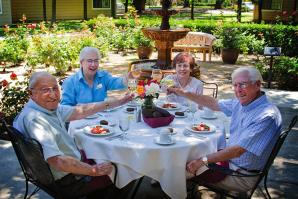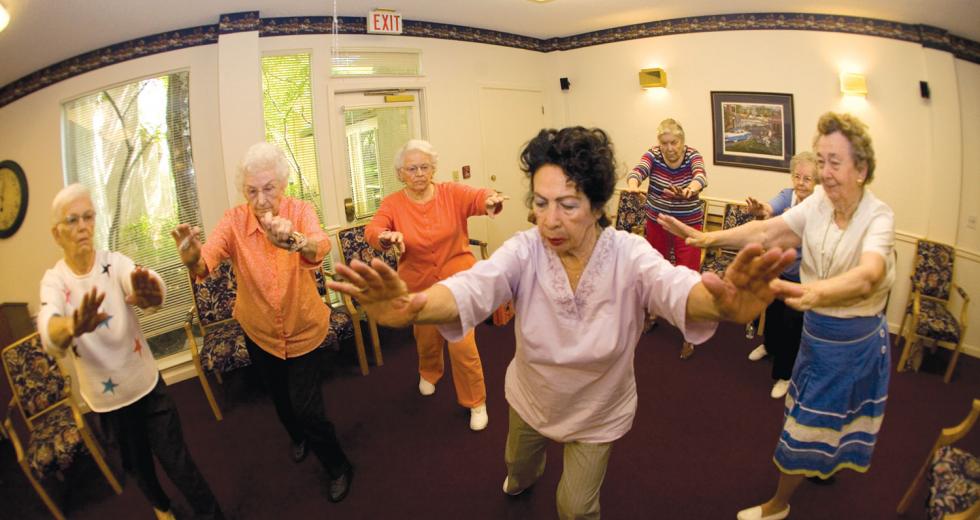Terri Bacon participates in line dancing, water aerobics and a book club in her community, Glenbrooke by Del Webb, which targets active adults older than 55. She recently started a club that attends theater performances. “I’m busier here than I’ve ever been, and I’m doing things that are worthwhile,” says Bacon, who turns 62 this month.
Baby boomers — the generation born between 1946 and 1964 — mean big bucks for the elder care industry. The sector is offering lifestyles and living arrangements that are attractive to individuals such as Bacon. An April study by MetLife’s Mature Market Institute and the National Association of Home Builders found that so-called active-adult communities are on the rise.
Colin Milner, CEO of the International Council on Active Aging, says most baby boomers are turned off by the word senior because they don’t see themselves as senior citizens. Milner adds that boomers aren’t looking at slowing down, and he says their ideal community is a “Shangri-La where everything you can dream of is under one roof.” He explains, “At the end of the day, they want a great experience.” Milner says companies such as Del Webb and K. Hovnanian are addressing baby boomers’ demands for remarkable experiences.
In the Capital Region, K. Hovnanian’s Four Seasons at Westshore boasts 31 acres of parks as well as tennis courts, a bike trail and other amenities. Sun City Roseville has a spa, weight room, massage room, indoor and outdoor heated pools, dance room, golf courses and sports courts, and it is planning a million-dollar addition to one of its meeting facilities. Communities such as Glenbrooke by Del Webb and Sun City Roseville also offer residents dozens of clubs and groups, including walking, sewing, cycling and billiards, plus classes in everything from fine arts to yoga.
Jacque Petroulakis, a spokesperson for Pulte Homes and its Del Webb communities, says lifestyle is a key ingredient in marketing active-adult communities. “Whether it’s offering enhanced fitness and wellness programs or developing an accredited college continuing education program, it’s the lifestyle components … that truly influence prospective buyers,” she says.
Donna O’Connell, Del Webb’s vice president of marketing in Sacramento, says Del Webb reaches out to prospective residents through a variety of media as well as through community events. “We’re selling a community and selling a lifestyle,” she says.
Active-adult communities aren’t the only ones reaching out to baby boomers. A handful of assisted living facilities also offer activities and amenities that appeal to this demographic. One local senior facility with new programming is Chateau at River’s Edge, which offers both independent living and assisted living. A couple years ago, Executive Director Steve Sarine closed down activities on the independent living side and introduced a concierge division that sends residents on trips and gets them out doing activities. “If somebody wants to go skydiving, we can make that happen,” he says. People who live in the independent living facility at River’s Edge are encouraged to take classes and participate in activities in the assisted living building.
To encourage participation, Sarine started a life enhancement program that offers River’s Edge residents a variety of activities in five main categories: spiritual, mental, physical, creative and social. River’s Edge residents can take yoga, join a Nintendo Wii bowling league or attend theater events. Each person gets an individual schedule tailored to his or her interests, something that’s attractive to boomers, who want more choices than the previous generation.
Lifelong learning and brain fitness are important to baby boomers. One company that’s catering to boomers’ desires for intellectual stimulation is Florida-based Praxeis, which creates “life fulfilling communities,” some of which are affiliated with universities. Locally, Glenbrooke by Del Webb is trying to start more educational classes for residents, and the community is pairing up with Sacramento-based Learning Exchange to offer courses. River’s Edge uses the Dakim BrainFitness system. Member-driven programs are another trend in senior living. Sarine says River’s Edge residents are in charge of groups and are involved in creating programs. “People need to have a part in creating their own quality of life,” he says.
At some communities, residents are also involved in marketing efforts. Del Webb features its residents in advertising and photo shoots. Sun City Roseville has videos of several active Sun City residents on the community’s website. At Sun City Roseville, resident Gary Myers heads up the Ambassador Committee, which works to attract new residents. To do so, the committee has sponsored events such as an expo directed at baby boomers. Myers says one of the challenges he and the other ambassadors face is changing the image of the community. “Many people think of active-adult communities as old folks’ homes,” he says. “We’re working on changing people’s mindset from ‘retirement community’ to ‘active-adult community.’”
A boon to travel
Baby boomers want remarkable experiences at home, but they also want these types of experiences on the road. Howie Lipson, co-founder of ElderTrav.com, says: “Baby boomers are looking for value and authenticity more than luxury. They also want to make good use of their time.”
In addition, baby boomers want to learn something on their trips. Nonprofit organization Elderhostel Inc. created its Road Scholar programs with boomers in mind. These programs emphasize active learning, and they offer participants hands-on activities and “behind-the-scenes experiences that would be difficult or impossible to arrange on your own.”
Since the economy’s turn downward, many seniors are taking rain checks on expensive adventures such as African safaris. “More and more baby boomers are staying closer to home, and U.S. national parks are a big hit this year,” Lipson says. Elderhostel notes that people are taking advantage of special offers on shipboard programs.
Del Webb has launched Stay and Play vacation programs and Day Pass programs, which let potential homebuyers check out some of its communities. Other active-adult communities have similar programs. Look at specific communities’ websites to see if they have vacation getaway programs.
What’s Medicare D all about?
Medicare prescription drug coverage is prescription insurance that covers both brand-name and generic drugs at participating pharmacies in your area. The plans included in the program are extensive, detailed and constantly changing. To clear the air, here are the answers to some of the most frequently asked questions.
Do I need to change my Medicare Part D plan every year? If I have found a plan that I am happy with, should I stay with it for the next year?
Medicare Part D plans change annually, so it is important to re-evaluate your plan every year because modifications can greatly impact the cost of your medications. This may be especially troublesome when previously covered medications are no longer insured. Furthermore, each year new Medicare Part D plans are introduced while others are discontinued. These new plans may offer better coverage at a lower cost than your current plan. To ensure you have the plan with the best coverage at the best price with the fewest restrictions for your medications, it is important to compare plans on a yearly basis during the open enrollment period (Nov. 15 through Dec. 31).
What may change about my plan each year?
Each year, a Medicare Part D plan may change its formulary (the
medications covered by the plan), the premium (the monthly
payment for your participations in the plan), the deductible (the
amount you pay before the plan benefits begin, if applicable),
the co-payment (your cost for each medication), the conditions of
the coverage gap (the portion of your prescription benefit in
which you may be responsible for 100 percent of your medication
costs) or the list of available pharmacies you may use to fill
your prescriptions.
My spouse and I have always chosen the same plan. Should we
continue to do that?
The choice of a Medicare Part D prescription drug plan should be
done on an individual basis because you are likely taking
different medications than your spouse. Since each Part D plan
has a different list of preferred medications, the most
cost-effective plan for you could be different than the plan for
your spouse. Furthermore, each Part D plan is only required to
cover a minimum of two medications from each medication class, so
evaluate your medications and plan choices yearly.
To determine the most cost-effective plan for you, visit the Medicare Prescription Drug Plan Finder at medicare.gov.
Angela Dai Zovi Leahy, Pharm.D., is a graduate of University of California, San Francisco School of Pharmacy.
Recommended For You

Better With Age
Emerging trends offer senior living with style
Retirement communities are facing the challenges that come with catering to seniors in the 21st century. These consumers — and there are a lot of them — are demanding greater access to technology, life-long learning programs and attention to overall wellness.

The Snowflake Strategy
To win with boomers, you’ll need individualized marketing
Let’s be honest, few generations were more aptly named than the baby boomers. While the moniker may have risen from a historically specific fertility trend, in many ways it has become a self-fulfilling prophecy. As writer P.J. O’Rourke once described it: “We’re stuck with being forever described as exploding infants.”



